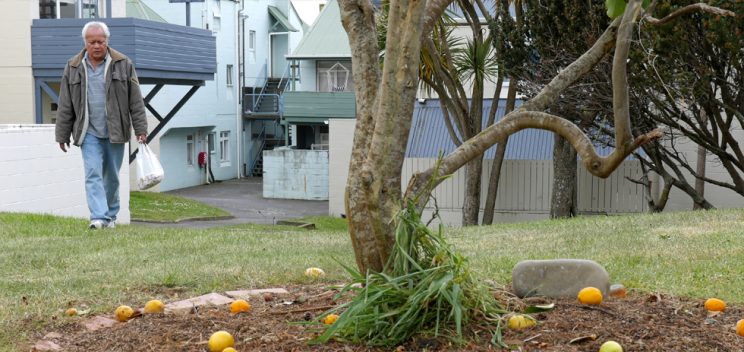
In One Thousand Ropes, director Tusi Tamasese offers a poignant rendering of a Samoan indigeneity, adrift and unmoored in urban diaspora of Aotearoa/New Zealand. Maea (played by Uelese Petaia) is a gentle elderly Samoan man, a day-time baker and an unlikely midwife who uses traditional healing practices. It’s a far cry from his youth, when he was a well-regarded neighbourhood fighter known as The Lion. In stark contrast to a familiar image of the close-knit Pacific Islander community or the ‘Jolly-Poly’, Maea leads a lonely life on the margins, guilty of committing domestic violence against his wife. His name, which literally translates to ‘rope,’ provides a metaphorical allusion to vital concepts of genealogy and tā-vā positionality in Polynesian cultures: the threads of ‘rope’ connecting his past, present and future fixate him, symbolising both severe disconnection and connection. Akin to Tamasese’s earlier The Orator (2011), which also took familial transgression and outcasts as its subject, here the director endeavours to realise a chorus of the in-between, as the film unfolds in potent and unsettling splices, punctuating a deliberately unhurried Samoan pace of storytelling.
The film begins in close-up on the strained face of a crying woman, sweaty and heaving with breath as she looks away. Over her shoulder, Maea sits on a fale holding a bloodied and crying newborn wrapped in a white sheet. He crawls over and places the child in her unwilling hands. Her womb, riddled with the trauma of assault, is the place from which Maea “massaged out Seipua”, the ghost-spirit of a woman residing in the cemetery near his house. Through muted tones, Tamasese daringly confronts the chilling notion of aitu in Samoan spiritual belief, which for many has profoundly superstitious and frightening connotations. He hints at the idea of Ma’i Aitu, a spirit-related mental illness which emphasises the presence of aitu as covert (though not explicitly recognised) control mechanism for appropriate role behaviour for people who have committed an immoral act. This catalyses Maea to atone for past violence which escalates when his estranged daughter Ilisa (played by Frankie Adams) arrives pregnant and seeking refuge away from her possessive boyfriend.
The film hones in on an over-familiar trope of Pacific Islander hyper-masculinity, a colonially instilled ‘savagery’ employed to normalise an inherent predisposition to violence. I am reminded of another ‘anti-hero’ of domestic violence in Aotearoa/New Zealand film, the Maōri patriarch Jake ‘the muss’ in Lee Tamahori’s Once Were Warriors (1993) whose aggressive ‘warriorhood’ has been both controversially derided and lauded in the years following the film’s release.1 Tamasese touches upon a pronounced herd-mentality of violence through Maea’s relationships with the men around him, who tease that he has faded from a ‘lion’ into nothing but a poor ‘sheep’. The director suggests how violence sparks inter-generational disarray in a scene wherein Maea turns on his younger co-worker, emphasising the frightening potential of a re-embedded cycle of violence.

However, Tamasese strategically bucks a monolithic understanding of Polynesian masculinity in favour of a more nuanced depiction of Maea’s struggle, who uses spirituality to regain himself within a diasporic context. Moving beyond Western tempo-spatial distinctions which divorce past/present, tradition/contemporaneity and community/individual, Tamasese explores ideas of ageing and renewal adheres to a more fluid assemblage of a ‘circular’ time expressed through Seipua’s forbidding (re-)arrivals as an old spirit into a newborn age. Stirring difficult memories of familial violence, the past is positioned as starkly ‘in front’ rather than ‘behind’ and out of mind. This is all embodied within the enduring motif of Maea’s weathered hands, capable of both healing and offence. We see him practice traditional massage with the utmost care on his female patients; a tangible connection with the tradition of his ancestors. Maea nurtures Ilisa’s gestation but his hands turn into fists when Seipua threatens revenge upon her unborn.
Maea’s personal conflict manifests elsewhere: at the bakery, in his rush to make keke pua’a (samoan bao) for customers before 5am. The deadline acts as a seemingly immanent expiration date for Maea. Each time he pounds the bread, it is underpinned by a defiance, a refusal to be outmoded by machine. His emotional and physical labour bears an uncanny resemblance to the natal labour of the women he looks after. Cinematographer Leon Narbey’s slow building momentum which renders distinct motifs of renewal such as hands, pregnancies, lemons, allowing the plot to flow and fill the lacunae of a minimal diegetic soundscape, a reminder of the harrowing subject matter of the film.
The inability of Ilisa to communicate in her father’s native tongue demonstrates the depth of the friction between generations. This discord is glaringly obvious considering the whole film is spoken in Samoan. Eventually, they restore their relationship in subtle and gentle recognition of each other but we are left to wonder: how are inter-generational issues and indigenous forms of knowledges to be communicated and transformed? Can changes and continuities transcribe a model of transformative justice?
For some, the film may play as ‘slow’, too dark or perhaps even a little unrealistic given the dis-inclusion of omnipresent symbols of Christian life, practices and values. The film presents a portrait of what it means to be a Samoan man in a purposeful untethering from aggression, for that it will likely be watched by generations. One Thousand Ropes, as an important contribution to Pasifika storytelling in new and exciting modes, presents important insights on gender and intergenerational issues and the Pacific migrant experience while also offering rich details of the complexities of Samoan culture such as time, spirituality and healing practices. We see a fluid transformation of Maea as the fibres of his own genealogical ‘rope’ are interpersonally mediated, severed, re-strung and remixed.
